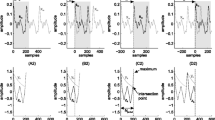Abstract
A new analytical method with high speed processing in the time-frequency domain is presented. In this method, sine and cosine waves with an established frequency and multiple periods are used, and we call these waves “cutting-out waves.” We all the frequency the “established frequency,” and we call the number of periods of the cutting-out wave the “number of periods.” The inner product of the cutting-out wave and the signal are calculated, and a signal element with a frequency near the established frequency is detected. We call the unit that detects the signal element an “auditory cell.” There are many auditory cells, and they have an established frequency which differs very little. The design of this method is the arrangement of the auditory cells. There are three parameters in the design, and these parameters are a sampling frequency, the number of periods, and the increasing rate of the established frequencies. In this article, we show the selection of these parameters.
Similar content being viewed by others
Explore related subjects
Discover the latest articles, news and stories from top researchers in related subjects.References
Nakatsuji H, Omatu S (2007) Real-time spectral analysis: electrical engineering in Japan. Wiley InterScience 161(1):43–50
Nakatsuji H, Omatu S (2009) Decomposition and reconstruction of signal in real-time spectral analysis: electronics and communication in Japan. Wiley InterScience 91(11):37–45
Nakatsuji H, Omatu S (2008) Decomposition and reconstruction of signal in high-speed processing method of real-time spectral analysis (in Japanese). IEEJ Trans EIS 128(7):1168–1175
Author information
Authors and Affiliations
Corresponding author
Additional information
This work was presented in part at the 15th International Symposium on Artificial Life and Robotics, Oita, Japan, February 4–6, 2010
About this article
Cite this article
Nakatsuji, H., Omatu, S. Selection of parameters in the design of real-time spectral analysis. Artif Life Robotics 15, 62–66 (2010). https://doi.org/10.1007/s10015-010-0767-x
Received:
Accepted:
Published:
Issue Date:
DOI: https://doi.org/10.1007/s10015-010-0767-x




